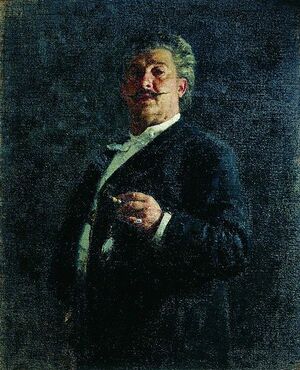Mikhail Mikeshin: Difference between revisions
mNo edit summary |
No edit summary |
||
| (One intermediate revision by one other user not shown) | |||
| Line 1: | Line 1: | ||
{{picture|file=Mikhail Mikeshin.jpg|caption='''Mikhail Mikeshin''' (1835-1896), in an 1888 portrait by Ilya Repin | {{picture|file=Mikhail Mikeshin.jpg|caption='''Mikhail Mikeshin''' (1835-1896), in an 1888 portrait by Ilya Repin}} | ||
Russian artist, sculptor and writer (b. 9/21 February 1835 in Roslavl, near [[Smolensk]]; d. 19/31 January 1896 in [[Saint Petersburg]]), born '''''Mikhail Osipovich Mikeshin''''' (Михаил Осипович Микешин). | Russian artist, sculptor and writer (b. 9/21 February 1835 in Roslavl, near [[Smolensk]]; d. 19/31 January 1896 in [[Saint Petersburg]]), born '''''Mikhail Osipovich Mikeshin''''' (Михаил Осипович Микешин). | ||
A student of the Imperial Academy of Arts from 1852 to 1858, his pictures of historical scenes won him the admiration of Russian royalty, and he was a tutor to junior members of the Imperial family. His first major sculptural work was the ''Millennium of Russia at Novgorod'' (1859). From 1876 to 1878 he also edited a satirical magazine ''The Bee'' (Пчела) | A student of the Imperial Academy of Arts from 1852 to 1858, his pictures of historical scenes won him the admiration of Russian royalty, and he was a tutor to junior members of the Imperial family. His first major sculptural work was the ''Millennium of Russia at Novgorod'' (1859). From 1876 to 1878 he also edited a satirical magazine ''The Bee'' (Пчела) | ||
When Mikeshin met Tchaikovsky in [[Saint Petersburg]] in September 1893, the composer agreed to write a [[March on Belorussian and Ukrainian Folk Tunes|March]] based on two folk | When Mikeshin met Tchaikovsky in [[Saint Petersburg]] in September 1893, the composer agreed to write a [[March on Belorussian and Ukrainian Folk Tunes|March]] based on two folk tunes suggested by Mikeshin, although this was not accomplished before Tchaikovsky's death a few weeks later. | ||
==Correspondence with Tchaikovsky== | ==Correspondence with Tchaikovsky== | ||
| Line 18: | Line 18: | ||
==External Links== | ==External Links== | ||
* [[wikipedia:Mikhail_Mikeshin|Wikipedia]] | * [[wikipedia:Mikhail_Mikeshin|Wikipedia]] | ||
* {{viaf|70031952}} | |||
[[Category:People|Mikeshin, Mikhail]] | [[Category:People|Mikeshin, Mikhail]] | ||
[[Category:Correspondents|Mikeshin, Mikhail]] | [[Category:Correspondents|Mikeshin, Mikhail]] | ||
[[Category:Writers|Mikeshin, Mikhail]] | [[Category:Writers|Mikeshin, Mikhail]] | ||
Latest revision as of 21:40, 18 August 2023
Russian artist, sculptor and writer (b. 9/21 February 1835 in Roslavl, near Smolensk; d. 19/31 January 1896 in Saint Petersburg), born Mikhail Osipovich Mikeshin (Михаил Осипович Микешин).
A student of the Imperial Academy of Arts from 1852 to 1858, his pictures of historical scenes won him the admiration of Russian royalty, and he was a tutor to junior members of the Imperial family. His first major sculptural work was the Millennium of Russia at Novgorod (1859). From 1876 to 1878 he also edited a satirical magazine The Bee (Пчела)
When Mikeshin met Tchaikovsky in Saint Petersburg in September 1893, the composer agreed to write a March based on two folk tunes suggested by Mikeshin, although this was not accomplished before Tchaikovsky's death a few weeks later.
Correspondence with Tchaikovsky
One letter from Tchaikovsky to Mikhail Mikeshin has survived, dating from 1893, and has been translated into English on this website:
- Letter 5026 – 3/15 September 1893 (?), from Saint Petersburg
Bibliography
- Памяти П. И. Чайковского (1893)
- Забытый эпизод (1940)
- Памяти П. И. Чайковского (1969)
- Белорусский автограф Чайковского (1984)

